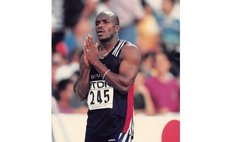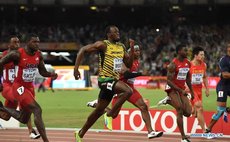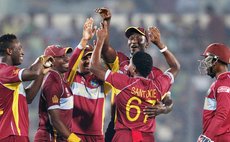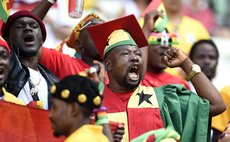Hattrick of Knighthoods
On 3rd February 1971, I had the privilege of managing the Combined Windwards and Leewards cricket team at Botanic Gardens, Roseau, in the Shell Shield regional tournament. The Islands had lost a previous engagement against Barbados ten days earlier in St. Lucia by nine wickets, and another against Trinidad and Tobago four days earlier at Port-of-Spain by an innings and four runs. One of the Islands' pacers versus Guyana was the then little known Anderson Montgomery Everton Roberts. In the match at the Gardens, Roberts, Grayson Shillingford and Norbert Phillip proceeded to capture 15 wickets between them and managed to inflict an unexpected defeat on the Guyanese under Rohan Kanhai.
Of signal consideration, Guyana listed eight men who had represented West Indies in Tests: Roy Fredericks, Steve Camacho, Basil Butcher, Clive Lloyd, Alvin Kallicharran, Rohan Kanhai, Phil Blair and Lance Gibbs. Three were to captain the West Indies in Lloyd, Kallicharran and Kanhai. Five were Test centurions and Gibbs was in due course to set a world record for the highest number of wickets in Tests.
I accorded myself the duty of convening a team meeting at its hotel the evening before the match to plan strategy. From what I recall not much attention was paid to the proceedings except by Mike Findlay (wicket keeper), Livingstone Harris (captain) and Irving Shillingford, the most senior player. Generally, the mood was business as usual. Guyana was expected to win easily.
One player who said little at the meeting was Roberts playing in his second full scale regional match. He took four wickets in the match, but importantly he dismissed Fredericks the Guyana top scorer with 68 and in the second innings he accounted for Kanhai, 18.
Upshot of the whole thing was a dramatic 50-run victory for the Combined Islands in a relatively low scoring match in which Irving Shillingford got 72 and 105, and Harris 60 in the second innings for the Islands. Elquemedo Willett captured four for 55 when Guyana batted a second time.
My strongest impression of that match of 43 years ago was the fact that Andy Roberts delivered at that time from a rather crouching posture. All this was remedied when he went to the Alf Gover Cricket School in London along with his Antiguan compatriot Vivian Richards. His bowling action was modified to a higher delivery point and he soon made his debut for West Indies at age 23 on March 6th 1974, at Barbados against England. He took one for 75 in 33 overs and two for 49 in 17 overs.
Roberts was dropped briefly but regained his place for the first Test against India at Bangalore on 22nd November, 1974. He bagged three for 65 and three for 24 as Lloyd and his men won by 267 runs. The rest is history. Andy Roberts soon formed part of a feared West Indies quartet of speedsters contributing largely to Lloyd's achievement of becoming the world's most successful Test captain.
At the age of 63 on 28th February, a few days ago Anderson Montgomery Everton Roberts was made a knight in a ceremony conducted at the Sir Vivian Richards Cricket Stadium during the interval of an ODI match between West Indies and England.
A place on the West Indies team came in 1983 at the age of 21, with an inauspicious debut—0 and 26 in the 4th Test against India at Bombay. His maiden Test century was 131 not out in the 3rd Test against Australia at Barbados in 1983. Nine of his Test centuries were recorded against Australian bowling and four against England. His highest Test score is 194 against India in Guyana (1988/89)
The third of the hattrick of cricketing knights was Curtley Elconn Lynwall Ambrose, whose wreckage of England for 47 runs at Port-of-Spain must stand as one of the most devastating feats in all cricket.
At a height of about 6 feet 7 inches the slim Antiguan at his best proved very difficult for batsmen to be certain as to whether to come forward or to go back in negotiating his swinging deliveries. In addition, Ambrose was blessed with an awkward lifting menace directed at the off stump. His career haul of 405 wickets from 98 Tests and 225 wickets from 176 One Day International matches is ample testimony to his lethal penetration as a match winning bowler. That he opted to bowl fast rather than pursue a beckoning career in basketball must stand as a marvellous benefit accruing to West Indies.
Ambrose at 23 made his regional debut in February of 1986 for Leewards versus Guyana but his candidacy to replace the awesome Joel Garner in the West Indies pace battery didn't materialize until a year later in a Test debut on 2nd April, 1988, against Pakistan at Guyana. However, on his installation in company of Malcolm Marshall and Courtney Walsh his true potential was unearthed with four for 53 and one for 56 to hold England to a draw at Nottingham in 1988. By the fourth Test at Leeds a strong cutting edge became evident with four for 58 and three for 40 in highlighting four defeats on the trot for England.
Also knighted were two other illustrious Antiguan cricketers. Richard Benjamin Richardson, 52, received the grand accolade on the strength of a career in which he amassed 5985 runs in Tests in which he flamboyantly compiled 16 centuries.
Richardson made his regional debut for Leewards in 1982 versus Barbados at the age of 20 scoring 0 and 76. He followed this the next year with 102 against Barbados and 156 against Jamaica and then 162 against Trinidad in 1984.
Andy Roberts, Ritchie Richardson and Curtley Ambrose have a lot to sing about regarding their exploits for West Indies. The last two are competent guitarists. Thus, nothing should hinder them in this regard. I offer them heartiest congratulations on their accession to the Knighthood. We wish all our young cricketers would seek eagerly to emulate them at regional and international levels. West Indies long awaits a true revival of quality in its cricket. Sir Andy's example of one who worked hard to sharpen his natural abilities is especially to be regarded as an achievement of true greatness. His was truly by the sweat of his brow.




